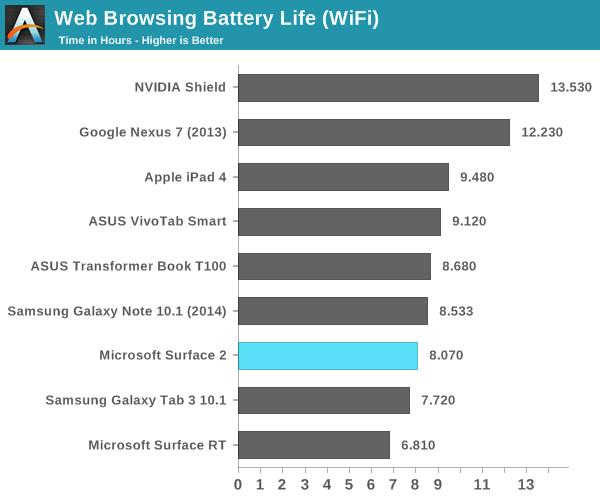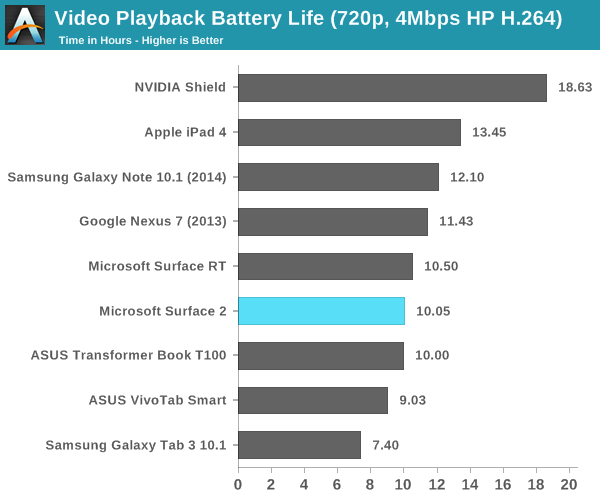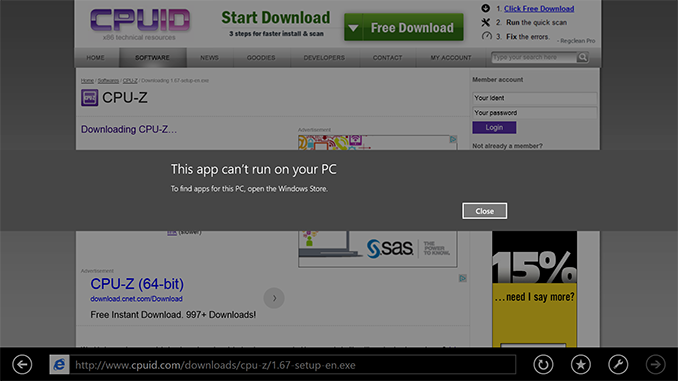Microsoft Surface 2 Review
by Anand Lal Shimpi on October 21, 2013 12:00 AM ESTBattery Life
Performance isn’t the only benefit that comes with Tegra 4 – NVIDIA and Microsoft also enjoy a smaller/lower power process: TSMC’s 28nm HPL. Of course four high-clocked Cortex A15 cores drives max power consumption higher than on Tegra 3, but idle power consumption and power efficiency at lower clock speeds should be better. As with most present day mobile devices, the move from Surface to Surface 2 comes with an increase in dynamic range of power consumption. I put Surface 2 (as well as Surface RT) through our 2013 tablet/smartphone web browsing battery life test and came away with around 8 hours of use on a single charge. That’s definitely not the lowest power that we’ve seen, but it is an improvement over the 6.8 hours Surface RT managed in the same test.

As with all modern Tegra SoCs there’s one extra “companion” core designed to be used for lower power/performance operation. Unlike under Android, there’s no hot plugging of CPU cores under Windows RT – there are always four Cortex A15s presented to the OS/scheduler, regardless of whether or not the companion core is active. Microsoft tells me the companion core is used on Surface 2 (unlike its predecessor), however specifics are tough to come by. Microsoft claims the companion core is used during full screen video playback. The only thing I can think of is that the hardware migrates the companion core in under certain circumstances, taking the place of one of the four A15s, and software specifically sets processor affinity in this case. I tried confirming whether or not this was the case by playing a movie and inspecting the process under task manager, unfortunately I came up empty handed. The video playback process wasn’t set to run on any one core in particular, it was allowed to run on all four exposed cores.

However it’s used, the impact seems to work relatively well. Surface 2 managed just over 10 hours of battery life in our video playback test. It’s not the best we’ve seen in this test, but it’s definitely competitive with other flagship devices.
Software
Surface 2 ships with Windows RT 8.1, and similarly absorbs all of the improvements that 8.1 brought to x86 machines as well. A number of ARM specific optimizations are under the hood, which should help improve both performance and power consumption.
The biggest issue with Surface 2 remains on the software front. Developer support for Windows Store applications is no where near where I thought it would be by now. There are some big ones (Netflix, Facebook), but there’s still no good Twitter client, no amazing IM client, and of course you don’t get good integration of Google services anywhere (outside of leveraging Mail for Gmail access).
Without opening up classic desktop APIs to developers, we won’t see alternative web browsers like Chrome or Firefox on Windows RT 8.1 either. Although IE11 does a relatively good job on the touch front, I find that heavy multitasking with IE11 on Surface 2 can result in a lot of hangs and crashes within tabs or the application itself. I can understand Microsoft’s hesitation on this front (better control over the platform if you don’t open it up), but I can’t see a future where Windows RT is successful and Microsoft doesn’t allow developers to access both sides of the platform.











139 Comments
View All Comments
Daniel Egger - Monday, October 21, 2013 - link
That's actually a big sucker. While some managed to compile desktop applications that can be used after a jailbreak I'd absolutely second the notion that this is something that needs proper Microsoft support, even if just in the form of proper compilation support with a hard signing requirement to prevent abuse.kyuu - Monday, October 21, 2013 - link
What exactly are you unable to do versus an Android or iOS tab? Keep in mind WinRT has a fully featured web browser that can actually run flash, and any missing app probably has a fully functional website alternative.IUU - Monday, October 21, 2013 - link
"Why we should even care?" We shouldn't actually, if current solutions were better than full windows, but they are not.It may be hard for a lot to swallow, but full windows is in reality orders of magnitude more useful and sophisticated than the pathetic and overestimated apps of these "ecosystems". Even an ugly x86 virus is much more of a program than the overhyped android or peaches and oranges apps, that you may have to pay for as well, while in x86 you are freely and painlessly infected.
Mobile is useful but not the most important in home computing. Trying to give it false significance, you get carried away by vain analyses about the mechanics of the kickstand, the premium feeling and the aesthetics of the user interface; this is a regress because you get excited by things that were difficult to do 10 years ago. Instead of getting excited for the next REALLY BIG APP, that would require 10s of gigabytes and several teraflops to run, you get excited by things so basic they ve been inforporated in oses long ago. So, sorry that I can't share your fascination. Surface is a good tablet, as the ipad and the droids are, very good for basic functions, nothing more nothing less.
I would suggest Microsoft come out of the hypnosis about the post pc era and concentrate on really interesting things, like how we could use more powerful devices than today's desktops.
Gambit2K - Monday, October 21, 2013 - link
I missed parts like if miracast is available for surface 2, if it is how does it work, how much battery does it drain etc.And didn't I read that twitter has launched an official app for RT about 1-2 months ago.
Steinegal - Monday, October 21, 2013 - link
Surface 2 does support Miracast, but I haven't seen any tests of it yet.And twitter is available in the store :)
UsernameAlreadyExists - Monday, October 21, 2013 - link
"Google’s Octane test is obviously best optimized for Chrome, and here we see solid performance although clearly behind the latest from Apple and Intel." Something wrong with the graph / this sentence, or am I reading the graph incorrectly?UsernameAlreadyExists - Monday, October 21, 2013 - link
Ah, the new stuff is missing from the graph.kyuu - Monday, October 21, 2013 - link
There's something wrong with the conclusion, since the Surface 2 clearly beats the iPad 4 in the Google Octane benchmark.Anand Lal Shimpi - Monday, October 21, 2013 - link
er fixed, thanks!JB_Gator - Monday, October 21, 2013 - link
I agree that the app situation is lacking but this isn't a huge issue for me anymore. Maybe I'm an atypical user, but I prefer light gaming in the phone context, along with to-do lists and other light/quick tasks. Also, most of the apps I'd be looking for are usually necessary due to lack of flash support in the browser.For example: Would a Spotify app look a little cleaner? Sure. But I can listen to playlists through the website but not the app anyway (mobile apps require premium). I can't do this on my Nexus or iPad. A lot of video sites would require apps to if it weren't for this (ESPN, HBO, etc.), but not only can I watch them on the Surface, but if I wanted to, I can stream them to my TV (through xbox) out of the box with a few clicks.
I was with you until you suggested it should be $399 with a type cover. That would be ludicrously cheap. The iPad, which is it's closest competitor (for better or for worse) is $499 with no cover. Also, Apple doesn't offer keyboards on its smart covers (yet?).
At its current price of $50 cheaper than the iPad, with additional benefits (MS Office, USB, microSD, microHDMI-out for extended desktop, split-screen multitasking) and some tradeoffs (apps) it is a great deal already.
I feel like even matching the iPad at $499 with a touch cover would be shockingly cheap, especially for new hardware of this quality. (Also, way more reasonable/likely).